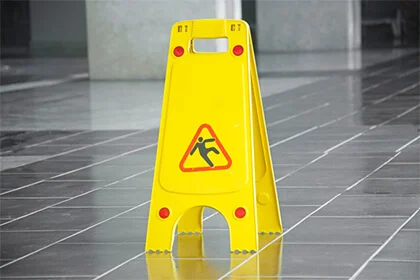The New South Wales Supreme Court decision of Rodd v Hall [2019] NSWSC 1304 is illustrative of a specific factual circumstance where a Plaintiff was able to establish negligence against the owners/managers of a motel for a slip and fall that occurred in the motel bathroom. In this decision, Hoeben CJ found for the Plaintiff and awarded damages in the sum of $470,690.92.[1] The Plaintiff’s damages, however, were subject to a reduction for contributory negligence in the order of 20%.[2]
THE MATERIAL FACTS
The Plaintiff was a paying guest at the Moruya Motel on 13 August 2013.
While showering in the bathroom of the motel room, a quantity of water made its way from under the shower curtain and onto the adjoining tiled floor.[3]
The Plaintiff had placed a shower mat on the floor prior to showering. The mat was completely saturated with water after the shower.
The Plaintiff placed a further two towels on the floor (including the towel she used to dry herself off) upon exiting the shower. The Plaintiff then left the bathroom ‘very carefully’ on account of the fact that she was aware that the floor would be very damp.[4]
The Plaintiff got dressed, put on her low-heeled boots and returned to the bathroom approximately one hour later to collect her toiletries and brush her teeth. She took approximately four steps from the main room into the bathroom and went to turn to the vanity basin when she slipped and fell, landing heavily on her right hip.[5]
The Plaintiff’s evidence described water streaming out from the shower into the centre of the bathroom. The Plaintiff also described being cautious of where she was going because of the fact water had been streaming out from the shower.[6] What the Plaintiff also emphasised, however, was that she was not expecting water to be present in the ‘thoroughfare and vanity end of the bathroom’.[7]
The subject shower curtain was measured by an expert in the case as approximately 90mm short of the floor.[8] The shower was not comprised of a hob or small step separating it from the rest of the tiles in the recessed area.[9]
RELEVANT LEGAL PRINCIPLES
The decision turned on the ability of the Plaintiff to establish, on the balance of probabilities, among other things, that:
- The Defendant owed her a duty of care.[10]
- The Defendant breached that duty of care due to a negligent act or omission.[11]
- The Defendant’s negligence caused her injury, loss and damage.[12]
The decision also considered the issue of contributory negligence[13] and the relevance of obvious risk.[14]
THE DECISION
His Honour found that the Defendant owed the Plaintiff a duty of care.[15] In coming to this conclusion, His Honour observed that the Plaintiff was a paying guest in the motel operated by the Defendants and as such, the Defendants had an obligation to take reasonable care to avoid foreseeable risks of harm to the Plaintiff, who was using reasonable care for their own safety.[16]
Hoeben CJ identified the relevant risk of harm in this case; that being, the risk of slipping on wet tiles where water had accumulated in an unexpected location.[17] His Honour noted that the Plaintiff was well aware of the danger of slipping on wet tiles but emphasised that the issue in this case was that the Plaintiff encountered wet tiles in a location (near the vanity, some distance from the shower) where the Plaintiff could not reasonably anticipate water being present.[18]
His Honour accepted the Plaintiff’s evidence on how the water streamed from the shower, as well as the evidence of the expert in relation to the shower/bathroom layout. In doing so, Hoeben CJ found that the risk of water travelling as far as the vanity was readily foreseeable by the defendants.[19] His Honour noted that the Defendant:[20]
‘Would have been well aware of the capacity of water to travel from the shower towards the toilet/vanity area… would have been well aware that the risk was not insignificant given the high level of slipperiness created by water coming in contact and remaining on tiles of this kind. I am satisfied that when running a motel of this kind, a reasonable person in the position of the defendants…should have taken at least some of the precautions identified by Mr Dohrmann [expert]. These precautions could have been implemented rapidly and at a low cost’.
The relevant precautions identified by Mr Dohrmann included ensuring the slip resistance standards governed by the applicable Australian Standard were met, placing adhesive, slip resistant strips on the tiled area, providing a shower curtain or other means of ensuring that water did not escape from the shower, installing a swing glazed door to retain water inside the shower and providing clear signs and warnings in the tiled area itself where the tiles were subject to becoming wet and slippery.[21]
Hoeben CJ went on to find that that the Defendant ought to have been aware that there was a high likelihood of harm occurring by way of a slip if precautions were not taken.[22] His Honour pointed to the test results of Mr Dohrmann indicating that a high level of slipperiness was created when water and the tiles combined and that the water had the capacity to flow a considerable distance from the shower.
As to foreseeability, His Honour rejected the Defendants’ argument that there had been no previous falls of this kind, finding that it is not decisive given the ‘readily foreseeable nature of harm’. Hoeben CJ observed that there might have been previous unreported falls with less serious consequences. Ultimately, His Honour found that the Plaintiff established a breach of duty of care on the part of the Defendants.[23]
As to causation, Hoeben CJ was satisfied that causation was established because the Plaintiff’s slip and fall accident would not have occurred but for the accumulation of water on the tiles in an unexpected location.[24] His Honour noted that the Plaintiff was conscious of the fact that water may still on the floor an hour after her shower when she walked towards the vanity. However, he observed that what the Plaintiff was not aware of and alert to was that water had accumulated in the vicinity of the vanity so that when she turned to collect her toiletries, she slipped. His Honour concluded that the unexpected location of a quantity of water on the tiles was a necessary condition for the occurrence of the accident.[25]
His Honour considered the application of ss 5F, 5G and 5H[26] to the case. He noted that the Plaintiff’s evidence was that she was aware of the risk of slipping on tiles when they were wet and took precautions to avoid this. Hoeben CJ was satisfied that these sections would apply if the relevant risk of injury were simply slipping on wet tiles and nothing else. However, His Honour went on to distinguish the facts of this case by reference to the risk of harm i.e. the risk of slipping on wet tiles in circumstances where the tiles were located in a place where one would not normally expect them to become wet.[27] His Honour observed:[28]
“…In those circumstances, there may well be some scope for a submission that this is a risk which was not obvious because of the circumstance that it was not reasonable to expect the tiles in this location to have become wet.’
Ultimately, His Honour found that because this case was not a failure to warn case, but rather a case where a reasonable person would have taken precautions, the issue of obvious risk did not need to be considered further.[29]
As to contributory negligence, Hoeben CJ noted that the Plaintiff was aware of the presence of water streaming into the directions of the toilet and vanity, that the mat was totally saturated and that the floor was so wet as to require her to put down two towels.[30] His Honour observed that in order to take reasonable care for her own safety, it was reasonable for the Plaintiff to keep a proper lookout for water when she was walking towards the vanity.[31] Ultimately, Hoeben CJ found that the Plaintiff failed to take reasonable care for her own safety in that she did not keep a proper lookout for the presence of water on the tiles.[32] The Plaintiff’s damages were reduced by 20%.[33]
If you have been injured in a slip and fall accident in a bathroom, Stacks Goudkamp may be able to assist you. For further information, enquiries can be made to Stacks Goudkamp’s Sydney office on 1800 251 800 or alternatively make an online enquiry.
Written by Alexander Morrison and Megan Sault.
Alexander Morrison is a Practice Group Leader specialising in motor vehicle claims and public liability claims that occur both within Australia and overseas.
Megan Sault is a Solicitor in Alexander Morrison’s Practice Group at Stacks Goudkamp.
[1] Rodd v Hall [2019] NSWSC 1304 [137] (Hoeben CJ).
[2] Ibid [62].
[3] Ibid [7].
[4] Ibid [8].
[5] Ibid.
[6] Ibid.
[7] Ibid.
[8] Ibid [19].
[9] Ibid.
[10] See specifically Australian Safeway Stores Pty Ltd v Zaluzna (1987) 162 CLR 479.
[11] Civil Liability Act 2002 (NSW) s 5B.
[12] Ibid s 5D.
[13] Rodd v Hall (n 1) [57-62].
[14] Ibid [53-6].
[15] Ibid [41].
[16] Ibid.
[17] Ibid [43].
[18] Ibid [44].
[19] Ibid [46].
[20] Ibid [47].
[21] Ibid [21].
[22] Ibid [47].
[23] Ibid [50].
[24] Ibid [53].
[25] Ibid.
[26] Civil Liability Act (n 12) ss 5F, 5G, 5H.
[27] Rodd v Hall (n 1) [55].
[28] Ibid.
[29] Ibid [56].
[30] Ibid [59].
[31] Ibid [60].
[32] Ibid.
[33] Ibid [62].



